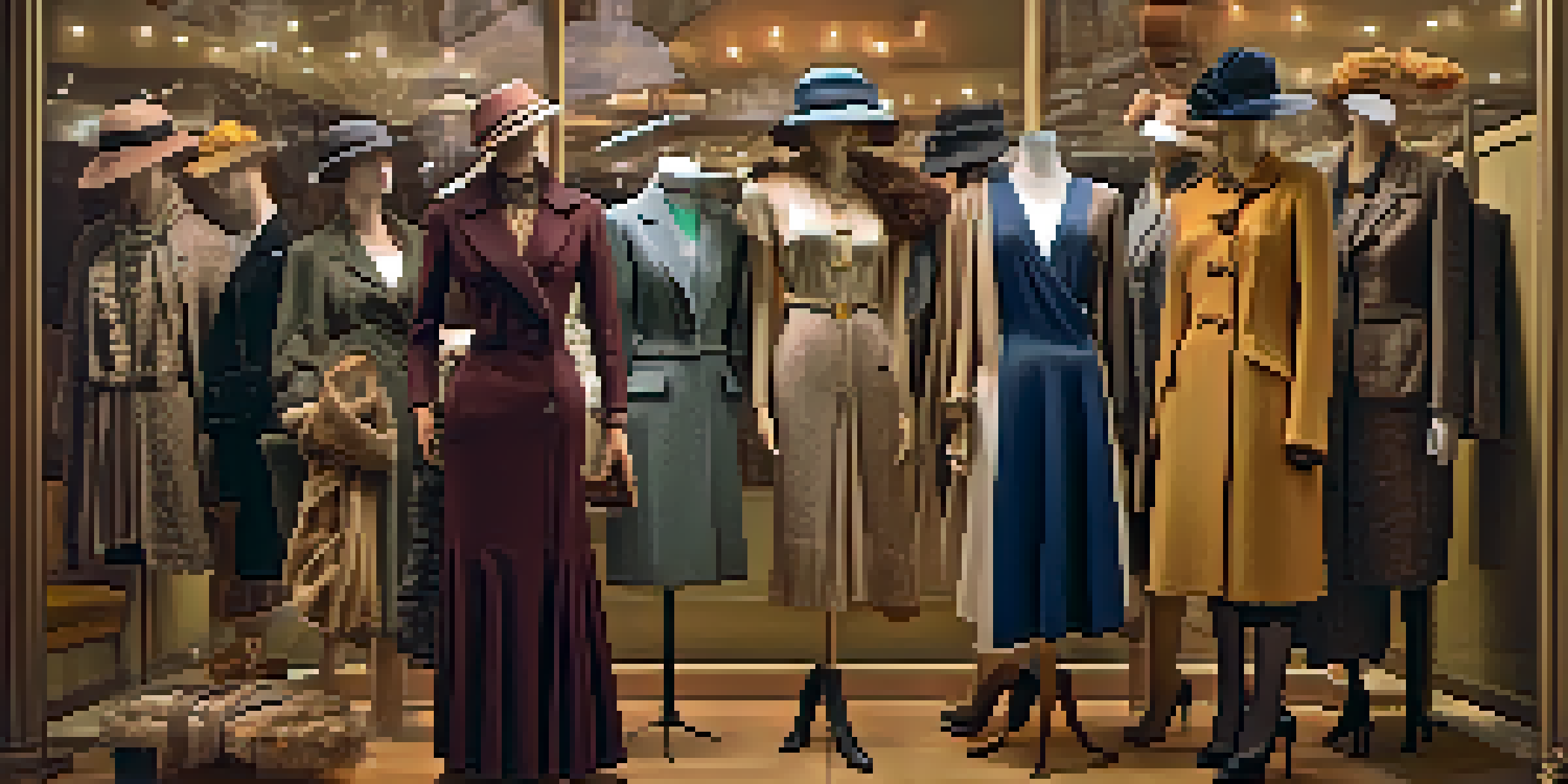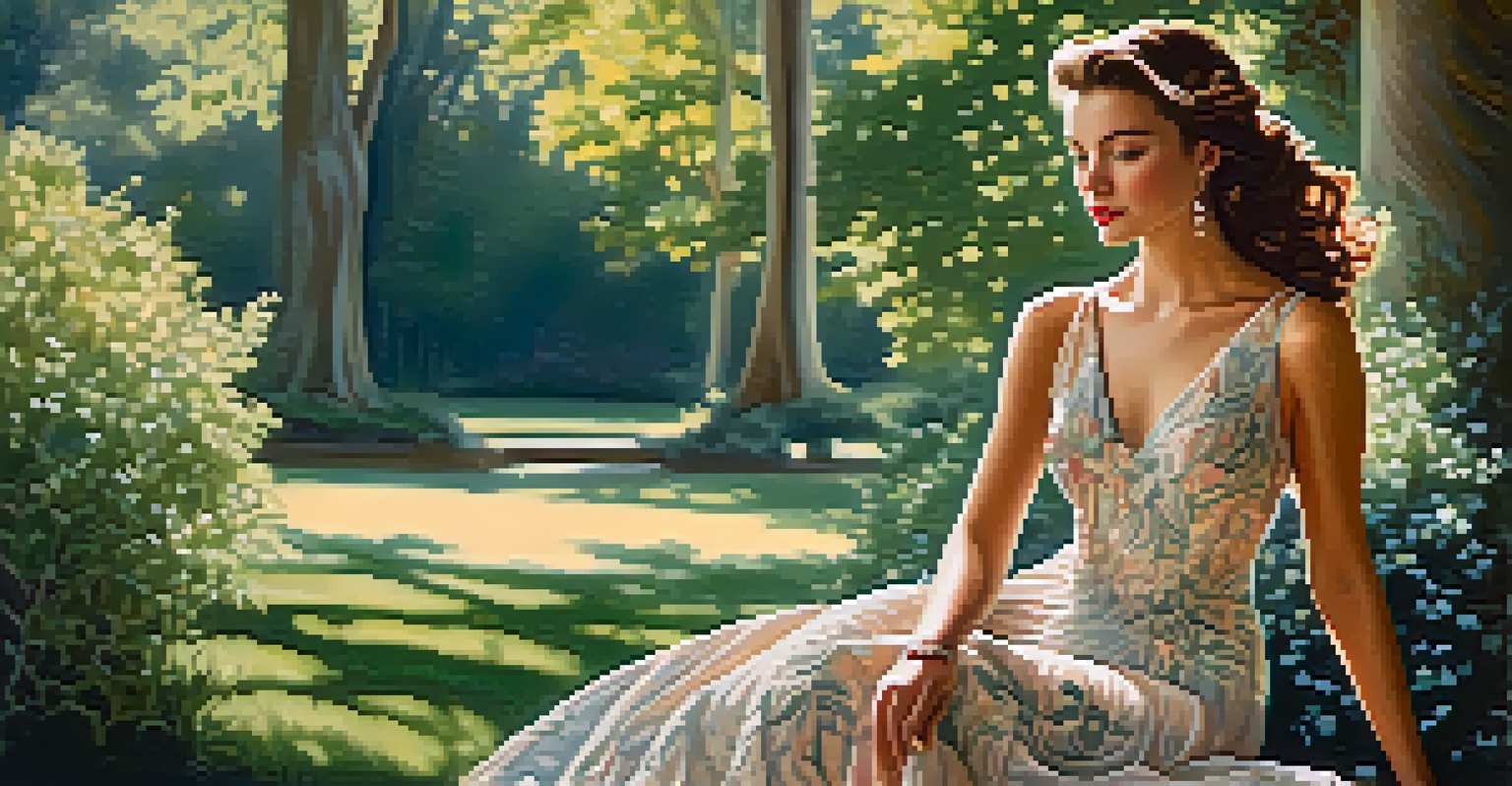The Impact of Vintage Fashion on Modern Luxury Trends

Understanding Vintage Fashion and Its Appeal
Vintage fashion refers to clothing and accessories that originate from a previous era, typically 20 years or older. This style evokes nostalgia and often features unique designs that stand out in today's fast-fashion world. The allure of vintage items lies in their story and craftsmanship, offering a stark contrast to mass-produced alternatives.
Fashion is about dressing according to what’s fashionable. Style is more about being yourself.
Many fashion enthusiasts are drawn to vintage pieces not just for aesthetics but also for cultural significance. Wearing vintage can be a form of self-expression, allowing individuals to connect with a particular time period or movement. This connection makes vintage fashion a compelling choice for those seeking authenticity in their wardrobe.
Moreover, vintage fashion promotes sustainability by encouraging the reuse of clothing, which is increasingly relevant in today’s eco-conscious society. As modern consumers become more aware of their purchasing impact, vintage items present an attractive alternative to new luxury goods, blending style with environmental responsibility.
The Resurgence of Vintage in High Fashion
In recent years, high fashion houses have embraced vintage aesthetics, often incorporating retro designs into their collections. Designers draw inspiration from past decades, blending classic silhouettes with contemporary materials. This fusion not only honors fashion history but also appeals to a broader audience looking for unique pieces.

Fashion shows frequently showcase vintage-inspired collections, highlighting how styles from the 1920s to the 1990s can be reimagined for the modern consumer. For instance, the resurgence of oversized blazers and tailored trousers echoes the power dressing of the 1980s, appealing to a new generation. These nods to the past enrich the luxury landscape, making it more dynamic and varied.
Vintage Fashion Promotes Sustainability
Choosing vintage clothing encourages eco-friendly practices by reusing items and reducing the impact of fast fashion.
Furthermore, vintage trends often create a sense of exclusivity. When brands incorporate vintage elements, they set themselves apart from competitors, offering something unique that resonates with consumers seeking individuality. This distinctiveness is a significant factor in today’s luxury market, where personalization plays a crucial role.
Celebrity Influence on Vintage Fashion Trends
Celebrities play a pivotal role in elevating vintage fashion to new heights. When stars are spotted wearing vintage pieces, it instantly garners attention and influences public perception. For example, red carpet events often feature vintage gowns, which can spark trends and inspire fans to seek similar styles.
The best things in life are free. The second best are very, very expensive.
Social media platforms amplify this effect, allowing fans to quickly access and replicate their favorite celebrity looks. Instagram and TikTok have become hotbeds for vintage fashion enthusiasts, where influencers share their retro finds and styling tips. This visibility helps to normalize vintage fashion and encourages more people to explore it.
Additionally, celebrities often collaborate with vintage boutiques and sustainable brands, further blurring the lines between luxury and vintage. Such partnerships highlight the appeal of timeless fashion while promoting eco-friendly choices. This trend not only boosts the popularity of vintage items but also aligns luxury fashion with contemporary values around sustainability.
The Role of Sustainability in Modern Luxury
Sustainability has become a crucial topic in the luxury fashion industry, as consumers increasingly demand eco-friendly practices. Vintage fashion offers a sustainable alternative, allowing individuals to enjoy luxury without the environmental impact of fast fashion. By choosing vintage, consumers can make responsible choices while still indulging in high-quality clothing.
The shift towards sustainability has prompted many luxury brands to rethink their production processes. Some are now focusing on creating timeless pieces that can withstand trends, encouraging consumers to invest in quality over quantity. This approach aligns well with the principles of vintage fashion, where longevity and craftsmanship are highly valued.
Celebrity Influence Drives Trends
Celebrities wearing vintage pieces boost their popularity, inspiring fans to embrace retro styles through social media.
As luxury brands continue to explore sustainable practices, vintage fashion serves as a vital source of inspiration. By incorporating vintage aesthetics and sustainable methods, brands can appeal to a growing demographic that prioritizes ethical consumption while still enjoying the allure of luxury.
Vintage Fashion's Impact on Luxury Brand Identity
Luxury brands are increasingly looking to vintage fashion to shape their identity and storytelling. By integrating retro elements, brands can evoke emotions and create a strong narrative that resonates with consumers. This emotional connection fosters loyalty, as customers feel aligned with the brand's history and values.
Additionally, vintage collaborations have become a popular strategy for luxury brands. By partnering with vintage boutiques or incorporating archival pieces into their collections, brands can create a sense of authenticity and exclusivity. This not only attracts vintage enthusiasts but also appeals to a broader audience seeking unique fashion experiences.
As a result, vintage fashion is not just a passing trend; it has become a pivotal element in defining modern luxury. Brands that successfully weave vintage influences into their identity can differentiate themselves in a crowded market, capturing the attention of discerning consumers.
The Intersection of Vintage and Modern Craftsmanship
Modern luxury is often characterized by meticulous craftsmanship and quality materials, qualities that vintage fashion naturally embodies. Many contemporary designers look to vintage techniques and styles to enhance their own creations. By marrying traditional craftsmanship with modern designs, they create pieces that are both timeless and relevant.
For example, hand-stitched details and luxurious fabrics that were once commonplace in vintage fashion are now making a comeback in contemporary collections. This resurgence highlights the importance of craftsmanship in luxury, as consumers seek items that reflect skill and artistry. The blending of old and new not only elevates fashion but also honors its rich history.
Luxury Brands Embrace Vintage Aesthetics
Integrating vintage elements allows luxury brands to create unique identities and connect emotionally with discerning consumers.
Ultimately, this intersection of vintage and modern craftsmanship encourages consumers to appreciate the artistry behind their clothing choices. As they gravitate towards pieces that showcase quality and heritage, the value of vintage fashion continues to rise within the luxury sector.
The Future of Vintage Fashion in Luxury Trends
Looking ahead, the influence of vintage fashion on luxury trends shows no signs of waning. As the industry evolves, more brands are likely to incorporate vintage aesthetics into their offerings. This trend not only reinforces the importance of heritage in fashion but also encourages innovation through the reinterpretation of classic styles.
Moreover, the desire for unique and personalized fashion experiences will continue to drive interest in vintage pieces. As consumers become more discerning, they will seek out items that reflect their individuality, making vintage a valuable resource for modern luxury. This demand will likely lead to an increased focus on curating one-of-a-kind collections.

In conclusion, vintage fashion has established itself as a significant force in shaping modern luxury trends. By embracing the past while looking toward the future, the fashion industry can create a vibrant dialogue between timeless elegance and contemporary style, assuring vintage's place in the luxury landscape for years to come.